Degas/Cassatt
May 11 - October 5, 2014
National Gallery of Art, Washington, DC
Edgar Degas's influence on fellow Impressionist Mary Cassatt is widely known, but her role in shaping his work and introducing him to American audiences is fully examined for the first time in this exhibition of seventy works in a variety of media -- National Gallery of Art
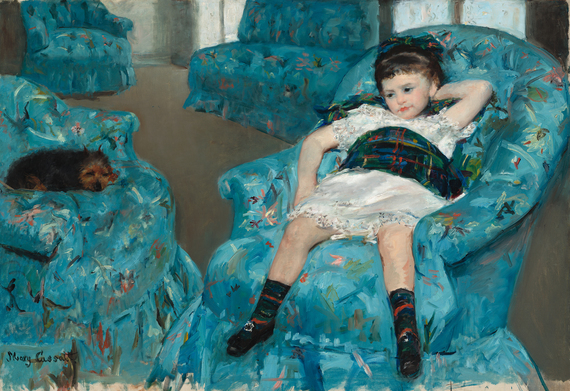
Mary Cassatt, "Little Girl in a Blue Armchair," 1878
oil on canvas
National Gallery of Art, Washington. Collection of Mr. & Mrs. Paul Mellon
© National Gallery of Art
I was 11 years old when I first set foot in the National Gallery of Art. My mom and I were on a short sightseeing visit to the nation's capital, and hitting up an art gallery was the about the last thing I wanted to do. I didn't really realize it at the time, but the visit ended up lighting a spark that over the years grew into one of the great passions of my life.
There are actually only three things I remember vividly from that day. First, I put my hands on a painting in the Old Masters' Room and chaos ensued (I'm pretty sure they keep an eye on me in there to this day). More happily, I remember being transfixed by Edgar Degas' iconic "Little Dancer Aged Fourteen" sculpture -- did the artist actually tie that real silk ribbon in her bronzed hair himself? Way back when? That tripped me out to no end. And thirdly, the image of my dear mother near tears in the presence of Mary Cassatt's magnificent "Child in a Straw Hat" will never leave me.
Now, over 30 years later, I've lived in Washington for over a decade and the National Gallery is a frequent stop for me and my own children -- none of whom, I am proud to say, have ever put their hands on a painting. Anyway, as you might imagine, the memories of that first visit came roaring back the minute I caught wind of a planned exhibit simply titled Degas/Cassatt. Opening this Sunday, May 11th, I managed to score a preview and an interview with Kimberly Jones, who serves as associate curator for the Department of French Paintings and who, along with senior conservator of paintings Ann Hoenigswald, took this wonderful, historic concept and made it into an exquisite reality (gotta shout out to Booz Allen Hamilton for sponsoring the exhibit in celebration of its 100th anniversary here as well).
CJ: Hi, Kimberly! First of all, let me just say that this is the greatest exhibit idea that never happened before. How did it come to be?
KJ: Well, it really came about very organically from our own collections, because we have such great holdings from both artists. Our Cassatt collection is among the greats, and we have the third largest collection of Degas in the world -- but we also have a number of really important singular pieces that speak to the particular subject. Girl Arranging Her Hair, a Cassatt picture that Degas had in his own collection, "Woman with a Fan", which is in our collection that was in the 1879 (Impressionist) show, and of course "Little Girl in a Blue Armchair" by Cassatt, which is really the star of the show and the painting which we now know Degas actually worked on.
CJ: Right. It's very obvious from both the printed materials and the physical layout here that "Little Girl in a Blue Armchair" is indeed kind of the cornerstone of the exhibit. Talk a little bit more about the work and its importance here
KJ: Well, it's interesting. We'd always known about this letter from Mary Cassatt to her dealer mentioning that Degas worked on the painting and worked on the background -- that's underlined in the letter and you can't miss it. But no one was ever able to really identify what Degas did -- what was the nature and extent of his intervention and so forth. So Anne Hoenigswald, our senior conservator of paintings and my collaborator on the project throughout, cleaned the painting, our science and research department studied the painting in depth for two years, more or less, trying to figure out just what Degas did.
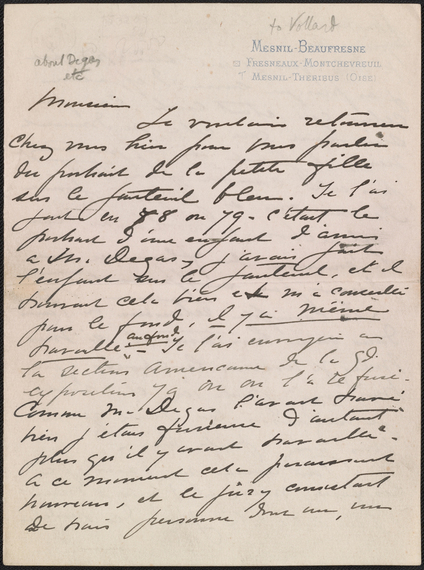
Letter from Mary Cassatt to Ambroise Vollard (first page) c. 1903
Mary Cassatt Letters, 1892-1925, Archives of American Art, Smithsonian Institution
CJ: And did he go nuts on it?
KJ: Well, what we discovered was that Degas made a very subtle but very dramatic change to the background. The back wall was initially horizontal--it was parallel to the edge of the canvas. So he came in and basically introduced a diagonal--just a corner--and he changed the whole space, making it recede and giving it a whole new dynamism. But it was only that little touch. And Cassatt, then, had to rework the canvas in conjunction with it. It was important for us because in studying the painting we learned what Degas did, but it also gave insights into how they worked together. In fact, what we really discovered is Degas' relationship with Cassatt was very respectful--he admired her talent and respected her talent--and they gave each other little nudges, back and forth, in a very respectful manner.
CJ: In fact, my next question was going to be in the process of putting this together, did you discover anything that you -- someone who is obviously a leading expert on the subject -- didn't know about the two of them...
KJ: I certainly learned a lot about Cassatt. I've worked on Degas quite a lot, as I am a French specialist and Cassatt is traditionally regarded as an American artist. She's now in our French department, however, so...
CJ: Wait. What? She got a promotion?
KJ: (laughs) Well, she spent her entire adult life and career in France and she's buried in France, so it makes sense. That said, we're probably the only museum that actually categorizes her as a French artist. Anyway, I knew plenty about Cassatt, but I think I didn't really appreciate the degree to which she was so experimental. I mean, we all know Cassatt as the painter of mothers and children and that popularity has kind of eclipsed everything else. But working on this, I came to really appreciate what an edgy artist she was. What a risk-taker she was. I mean, the prints that she does are extraordinary and are not the things that people normally see. They don't fit the neat and tidy story of Mary Cassatt. I mean, the work in mixed media... she's much more surprising and dynamic than she's ever given credit for.
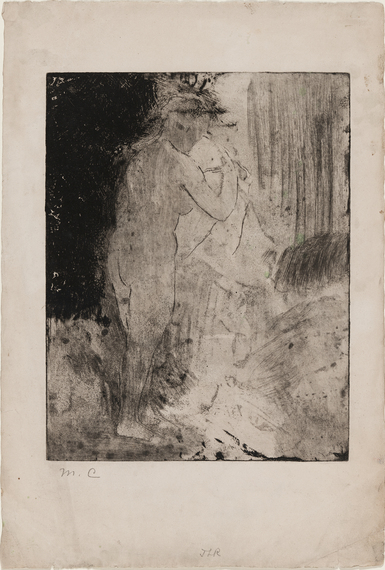
Mary Cassatt, "Standing Nude With a Towel," c. 1879
soft ground etching, drypoint and aquatint
Museum of Fine Arts, Boston. Gift of Henri M. Petiet, confirmed by his estate
Photograph © Museum of Fine Arts, Boston
CJ: And that really does come through very clearly in this exhibit. Really.
KJ: Yes! And this is her -- these are things that she did all along. We're not making anything up!
CJ: But you are right in that the story of Cassatt has always been kind of a neat and tidy one. There a lot of very pleasant surprises here.
KJ: That's what I hope -- that when people see it they'll be surprised.
CJ: I've been anxious to ask you more about how these two came to be so close. I mean, with Degas being such a misanthrope, misogynist, fully-confirmed bachelor and so forth... one thing that's very clear from this exhibit is how extremely close the two were for a very long time. What do you attribute it to? Clearly it wasn't a romantic situation or anything of the sort...
KJ: No, there's been absolutely no intimation of anything romantic. If there were something, someone would have said something along the way by comments, sly remarks, what have you. But there's nothing. She was a committed bachelorette as well, of course. I think people focus on the things that are different -- nationality, gender -- but I think they forget about the things they have in common, such as the fact that they were both actually raised in privileged environments with both families being in banking, both very well educated, very witty, same social class, moved in the same social circles and so forth. In fact, in the Impressionist group those two actually had a lot more in common than Degas would have with someone like Monet, Renoir or Pisarro, who were all working class. So they really had a rapport that came solely from their backgrounds.
CJ: Kindred spirits.
KJ: The comment from Degas regarding Cassatt that's always quoted is that upon first viewing her work he said "there is someone who feels as I do." Not so much "there's a great artist"...it was first the shared sentiment and sensibility -- I mean, she was a great artist obviously.
CJ: Didn't he also exclaim "no woman should ever be able to paint like this?"
KJ: Yes. Yes, he did. And it was a dig, but also she knew enough to take it for what it was -- a kind of grudging respect. He wasn't so much a misogynist as just a misanthrope. He didn't like a lot of people and was a hard person to deal with. But she was tough too, you know. She was very independent, very stubborn... she knew her own mind and would not deviate for anyone and that was a big part of the kindred spirit that they recognized. They had a kind of tunnel-vision when it came to their art, they were absolutely 100 percent dedicated to it, they were hard working, always willing to try new things...
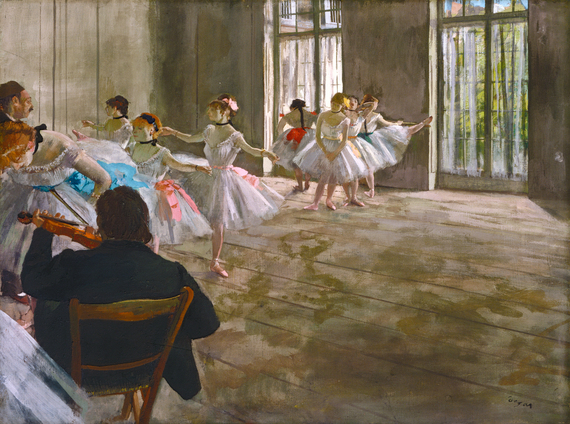
Edgar Degas "Rehearsal in the Studio," c. 1878-1879
egg tempera on canvas
Collection of Shelburne Museum. Gift of Electra Webb Bostwick
© Shelburne Museum, Shelburne, Vermont
CJ: It's pretty much all the two of them wanted to do, right? No romance, no distractions, or what have you.
KJ: All the drama, all the mistresses, children and other things, they didn't have time for that. They wanted to be alone, and that's something they recognized in each other. But they would fall out also. There'd be times when he would say something and she would just... they wouldn't speak for months, and then they always came back because at the end of the day there was that respect and mutual admiration that was always there.
CJ: One of the many things I learned from the exhibit was that toward the end of their lives they grew apart. I was surprised, in fact, to learn that she had grown tired of Degas' iconic portrait, "Mary Cassatt," that had hung in her studio for years, and sold it without telling him. Was the increasing distance in those later years just a natural occurrence or did something go down?
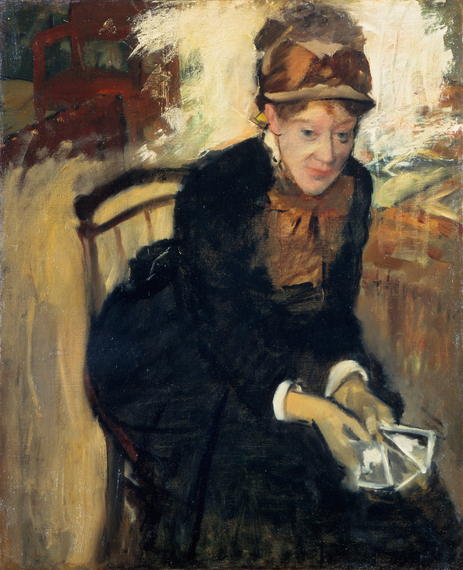
Edgar Degas "Mary Cassatt," c. 1879-1884
National Portrait Gallery, Smithsonian Institution. Gift of Morris and Gwendolyn Cafritz Foundation and the Regents' Major Acquisitions Fund, Smithsonian Institution
National Portrait Gallery, Smithsonian Institution / Art Resource, NY
KJ: I think a lot of that was just the inevitability of aging. By this time, late in life, she was living in Beauvais so she wasn't in Paris very much. They were both aging and having difficulty with their eyesight and just didn't see each other often. Cassatt also became increasingly conservative. They did have a falling out when it came to the Dreyfus Affair. Cassatt was very pro-Dreyfus and Degas was very, very anti-Dreyfus, so that drove a big wedge between them, which they eventually overcame.
CJ: Considering the crotchetiness of the two when they were young, I can't begin to imagine what they must have been like in old age. But selling the portrait without telling him?
KJ: Certainly in Cassatt's later years she did things like destroy correspondence with Degas -- she destroyed a lot of correspondence, in fact. She started to cull her collection, and there were intimations in letters that she even destroyed some of her own art. She was thinking about her legacy in those later years and was streamlining and getting rid of all sorts of things. She didn't just get rid of the Degas but Pisarros, Monets, all the other art that she owned was sold off. So it wasn't just that portrait, but part of a bigger trend in her life at that time.
CJ: So it was purely business, not personal.
KJ: It just wasn't the image she wanted people to think of her by. She was very explicit that she did not want it going to an American collection because she didn't want her name attached and the American collectors would know it was her. Ironically, it now usually hangs in the National Portrait Gallery in Washington with her name very much attached. So everything she tried to avoid in that regard happened.
CJ: You've been so generous with your time today, and once again, congratulations on what really is a masterpiece of an exhibit. Anything else you want people to walk away from Degas/Cassatt with?
KJ: Well, I hope people will see the names, which they are familiar with, and I hope that they'll leave some of their expectations at the door, so that when they come in and see all of these amazing things they've never seen before, they'll come away with a whole new understanding of both artists. It's going to be a surprise for many, and a real gratifying experience, I suspect. Overall, I just hope they'll come, spend lots of time, and just enjoy the art.
Big Cool Update! Thursday, May 8, 2014
So it seems a very special guest strolled into the National Gallery this morning for a preview...

Julie Thayer Behr with a portrait of her great-great aunt Mary Cassatt, painted by Edgar Degas c. 1879-1884, on view in the exhibition Degas/Cassatt at the National Gallery of Art (May 11-October 5). The portrait is on loan from the National Portrait Gallery, also in Washington, DC.
"Most things in this exhibition I've only seen in pictures. It is an overwhelming delight to see them in person," she said.
Julie Thayer Behr's grandfather was Edward Buchanon Cassatt. He was a son of Alexander Cassatt, who was Mary Cassatt's brother.
Degas/Cassatt opens this Sunday, May 11th
(Photo by Anabeth Guthrie, National Gallery of Art)

